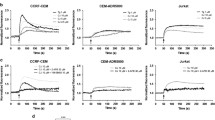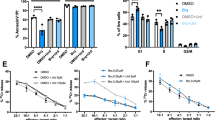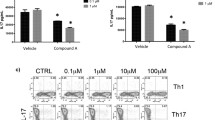Abstract
T cells respond to antigen stimulation with the rapid release of cellular ATP, which stimulates an autocrine feedback mechanism that regulates calcium influx through P2X receptors. This autocrine purinergic feedback mechanism plays an essential role in the activation of T cells resulting in cell proliferation and clonal expansion. We recently reported that increases in mitochondrial ATP production drive this stimulation-induced purinergic signaling mechanism but that low-level mitochondrial ATP production fuels basal T cell functions required to maintain vigilance of unstimulated T cells. Here we studied whether defects in these purinergic signaling mechanisms are involved in the unwanted proliferation of leukemia T cells. We found that acute leukemia T cells (Jurkat) possess a larger number and more active mitochondria than their healthy counterparts. Jurkat cells have higher intracellular ATP concentrations and generat more extracellular ATP than unstimulated T cells from healthy donors. As a result, increased purinergic signaling through P2X1 and P2X7 receptors elevates baseline levels of cytosolic Ca2+ in Jurkat cells. We found that pharmacological inhibition of this basal purinergic signaling mechanism decreases mitochondrial activity, Ca2+ signaling, and cell proliferation. Similar results were seen in the leukemic cell lines THP-1, U-937, and HL-60. Combined treatment with inhibitors of P2X1 or P2X7 receptors and the chemotherapeutic agent 6-mercaptopurine completely blocked Jurkat cell proliferation. Our results demonstrate that increased mitochondrial metabolism promotes autocrine purinergic signaling and uncontrolled proliferation of leukemia cells. These findings suggest that deranged purinergic signaling can result in T cell malignancy and that therapeutic targeting aimed at purinergic signaling is a potential strategy to combat T cell leukemia.







Similar content being viewed by others
References
Siegel R, Ma J, Zou Z, Jemal A (2008) Cancer statistics, 2014. CA Cancer J Clin 64:9–29
Pui CH, Robison LL, Look AT (2008) Acute lymphoblastic leukaemia. Lancet 371:1030–1043
Pui CH (2009) T cell acute lymphoblastic leukemia: NOTCHing the way toward a better treatment outcome. Cancer Cell 15:85–87
Dores GM, Devesa SS, Curtis RE, Linet MS, Morton LM (2012) Acute leukemia incidence and patient survival among children and adults in the United States, 2001–2007. Blood 119:34–43
Riscoe MK, Brouns MC, Fitchen JH (1989) Purine metabolism as a target for leukemia chemotherapy. Blood Rev 3:162–173
Poplack DG, Blatt J, Reaman G (1981) Purine pathway enzyme abnormalities in acute lymphoblastic leukemia. Cancer Res 41:4821–4823
Zimmermann H, Zebisch M, Sträter N (2012) Cellular function and molecular structure of ecto-nucleotidases. Purinergic Signal 8:437–502
Junger WG (2011) Immune cell regulation by autocrine purinergic signalling. Nat Rev Immunol 11:201–212
Filippini A, Taffs RE, Sitkovsky MV (1990) Extracellular ATP in T-lymphocyte activation: possible role in effector functions. Proc Natl Acad Sci U S A 87:8267–8271
Schenk U, Westendorf AM, Radaelli E, Casati A, Ferro M, Fumagalli M, Verderio C, Buer J, Scanziani E, Grassi F (2008) Purinergic control of T cell activation by ATP released through pannexin-1 hemichannels. Sci Signal 1(39):ra6
Yip L, Woehrle T, Corriden R, Hirsh M, Chen Y, Inoue Y, Ferrari V, Insel PA, Junger WG (2009) Autocrine regulation of T-cell activation by ATP release and P2X7 receptors. FASEB J 23:1685–1693
Woehrle T, Yip L, Elkhal A, Sumi Y, Chen Y, Yao Y, Insel PA, Junger WG (2010) Pannexin-1 hemichannel-mediated ATP release together with P2X1 and P2X4 receptors regulate T-cell activation at the immune synapse. Blood 116:3475–3484
Ledderose C, Bao Y, Lidicky M, Zipperle J, Li L, Strasser K, Shapiro NI, Junger WG (2014) Mitochondria are gate-keepers of T cell function by producing the ATP that drives purinergic signaling. J Biol Chem 289:25936–25945
Yip L, Cheung CW, Corriden R, Chen Y, Insel PA, Junger WG (2007) Hypertonic stress regulates T-cell function by the opposing actions of extracellular adenosine triphosphate and adenosine. Shock 27:242–250
Sumi Y, Woehrle T, Chen Y, Bao Y, Li X, Yao Y, Inoue Y, Tanaka H, Junger WG (2014) Plasma ATP is required for neutrophil activation in a mouse sepsis model. Shock 42:142–147
Kurishita Y, Kohira T, Ojida A, Hamachi I (2012) Organelle-localizable fluorescent chemosensors for site-specific multicolor imaging of nucleoside polyphosphate dynamics in living cells. J Am Chem Soc 134:18779–18789
Ledderose C, Bao Y, Ledderose S, Woehrle T, Heinisch M, Yip L, Zhang J, Robson SC, Shapiro NI, Junger WG (2016) Mitochondrial dysfunction depletes purinergic signaling mechanisms needed for T cell vigilance and immune defense. J Infect Dis 213:456–464
Zhi-Jun Y, Sriranganathan N, Vaught T, Arastu SK, Ahmed SA (1997) A dye-based lymphocyte proliferation assay that permits multiple immunological analyses: mRNA, cytogenetic, apoptosis, and immunophenotyping studies. J Immunol Methods 210:25–39
Albini A, Sporn MB (2007) The tumour microenvironment as a target for chemoprevention. Nat Rev Cancer 7:139–147
Ohta A, Gorelik E, Prasad SJ, Ronchese F, Lukashev D, Wong MK, Huang X, Caldwell S, Liu K, Smith P, Chen JF, Jackson EK, Apasov S, Abrams S, Sitkovsky M (2006) A2A adenosine receptor protects tumors from anti-tumor T cells. Proc Natl Acad Sci U S A 103:13132–13137
Pellegatti P, Raffaghello L, Bianchi G, Piccardi F, Pistoia V, Di Virgilio F (2008) Increased level of extracellular ATP at tumor sites: in vivo imaging with plasma membrane luciferase. PLoS ONE 3(7), e2599
Yegutkin GG, Mikhailov A, Samburski SS, Jalkanen S (2006) The detection of micromolar pericellular ATP pool on lymphocyte surface by using lymphoid ecto-adenylate kinase as intrinsic ATP sensor. Mol Biol Cell 17:3378–3385
Warburg O (1956) On the origin of cancer cells. Science 123:309–314
Pendergrass W, Wolf N, Poot M (2004) Efficacy of MitoTracker Green and CMXrosamine to measure changes in mitochondrial membrane potentials in living cells and tissues. Cytometry A 61:162–169
Keij JF, Bell-Prince C, Steinkamp JA (2000) Staining of mitochondrial membranes with 10-nonyl acridine orange, MitoFluor Green, and MitoTracker Green is affected by mitochondrial membrane potential altering drugs. Cytometry 39:203–210
Burnstock G, Fredholm BB, North RA, Verkhratsky A (2010) The birth and postnatal development of purinergic signaling. Acta Physiol 199:93–147
White N, Burnstock G (2006) P2 receptors and cancer. Trends Pharmacol Sci 27:211–217
Burnstock G, Di Virgilio F (2013) Purinergic signaling and cancer. Purinergic Signal 9:491–540
Antonioli L, Blandizzi C, Pacher P, Hasko G (2013) Immunity, inflammation and cancer: a leading role for adenosine. Nat Rev 13:842–857
Di Virgilio F, Ferrari D, Adinolfi E (2009) P2X7: a growth-promoting receptor—implications for cancer. Purinergic Signal 5:251–256
Baricordi OR, Melchiorri L, Adinolfi E, Falzoni S, Chiozzi P, Buell G, Di Virgilio F (1999) Increased proliferation rate of lymphoid cells transfected with the P2X(7) ATP receptor. J Biol Chem 274:33206–33208
Zhang XJ, Zheng GG, Ma XT, Yang YH, Li G, Rao Q, Nie K, Wu KF (2004) Expression of P2X7 in human hematopoietic cell lines and leukemia patients. Leuk Res 28:1313–1322
Adinolfi E, Melchiorri L, Falzoni S, Chiozzi P, Morelli A, Tieghi A, Cuneo A, Castoldi G, Di Virgilio F, Baricordi OR (2002) P2X7 receptor expression in evolutive and indolent forms of chronic B lymphocytic leukemia. Blood 99:706–708
Vander Heiden MG, Cantley LC, Thompson CB (2009) Understanding the Warburg effect: the metabolic requirements of cell proliferation. Science 324:1029–1033
Weinberg SE, Chandel NS (2015) Targeting mitochondria metabolism for cancer therapy. Nat Chem Biol 11:9–15
Wallace DC (2012) Mitochondria and cancer. Nat Rev Cancer 12:685–698
Zu XL, Guppy M (2004) Cancer metabolism: facts, fantasy, and fiction. Biochem Biophys Res Commun 313:459–465
Bao Y, Ledderose C, Seier T, Graf AF, Brix B, Chong E, Junger WG (2014) Mitochondria regulate neutrophil activation by generating ATP for autocrine purinergic signaling. J Biol Chem 289:26794–26803
Bao Y, Ledderose C, Graf AF, Brix B, Birsak T, Lee A, Zhang J, Junger WG (2015) mTOR and differential activation of mitochondria orchestrate neutrophil chemotaxis. J Cell Biol 210:1153–1164
Galluzzi L, Bravo-San Pedro JM, Vitale I, Aaronson SA, Abrams JM, Adam D, Alnemri ES, Altucci L, Andrews D, Annicchiarico-Petruzzelli M et al (2015) Essential versus accessory aspects of cell death: recommendations of the NCCD 2015. Cell Death Differ 22:58–73
Voogd TE, Vansterkenburg ELM, Wilting J, Janssen LHM (1993) Recent research on the biological activity of suramin. Pharmacol Rev 45:177–203
La Rocca RV, Danesi R, Cooper MR, Jamis-Dow CA, Ewing MW, Linehan WM, Myers CE (1991) Effect of suramin on human prostate cancer cells in vitro. J Urol 145:393–398
Taylor CW, Lui R, Fanta P, Salmon SE (1992) Effects of suramin on in vitro growth of fresh human tumors. J Natl Cancer Inst 84:489–494
Rubio GJ, Pinedo HM, Virizuela J, van Ark-Otte J, Giaccone G (1995) Effects of suramin on human lung cancer cell lines. Eur J Cancer 31A:244–251
Hosang M (1985) Suramin binds to platelet-derived growth factor and inhibits its biological activity. J Cell Biochem 29:265–273
Pollak M, Richard M (1990) Suramin blockade of insulin-like growth factor I-stimulated proliferation of human osteosarcoma cells. J Natl Cancer Inst 82:1349–1352
Figg WD, Cooper MR, Thibault A, Headlee D, Humphrey J, Bergan RC, Reed E, Sartor O (1994) Acute renal toxicity associated with suramin in the treatment of prostate cancer. Cancer 74:1612–1614
Dawson NA, Cooper MR, Figg WD, Headlee DJ, Thibault A, Bergan RC, Steinberg SM, Sausville EA, Myers CE, Sartor O (1995) Antitumor activity of suramin in hormone-refractory prostate cancer controlling for hydrocortisone treatment and flutamide withdrawal as potentially confounding variables. Cancer 76:452–463
Small EJ, Meyer M, Marshall ME, Reyno LM, Meyers FJ, Natale RB, Lenehan PF, Chen L, Slichenmyer WJ, Eisenberger M (2000) Suramin therapy for patients with symptomatic hormone-refractory prostate cancer: results of a randomized phase III trial comparing suramin plus hydrocortisone to placebo plus hydrocortisone. J Clin Oncol 18:1440–1450
Beavis PA, Stagg J, Darcy PK, Smyth MJ (2012) CD73: a potent suppressor of antitumor immune response. Trends Immunol 33:231–237
Antonioli L, Blandizzi C, Pacher P, Haskó G (2013) Immunity, inflammation and cancer: a leading role for adenosine. Nat Rev Cancer 13:842–857
Robak P, Robak T (2013) Older and new purine nucleoside analogs for patients with acute leukemias. Cancer Treat Rev 39:851–861
Salam L, Abdel-Wahab O (2015) Hairy cell leukemia: update and current therapeutic approach. Curr Opin Hematol 22:355–361
Birsoy K, Possemato R, Lorbeer FK, Bayraktar EC, Thiru P, Yucel B, Wang T, Chen WW, Clish CB, Sabatin DM (2014) Metabolic determinants of cancer cell sensitivity to glucose limitation and biguanides. Nature 508:108–112
Acknowledgments
This work was funded in part by grants from the National Institutes of Health, GM-51477, GM-60475, AI-080582, and T32GM103702 (W.G.J.), and from the German Research Foundation (DFG), LE-3209/1-1 (C.L.). We thank Drs. Yasutaka Kurishita and Itaru Hamachi for kindly providing the fluorescent ATP probe 2-2Zn(II).
Author information
Authors and Affiliations
Corresponding author
Ethics declarations
Conflict of Interest
The authors declare that they have no conflicts of interest.
Ethical approval
All procedures performed in this study involving human participants were in accordance with the ethical standards of the institutional research committee and with the 1964 Helsinki declaration and its later amendments or comparable ethical standards.
Informed consent
Informed consent was obtained from all individual participants included in the study.
Electronic supplementary material
Below is the link to the electronic supplementary material.
Supplemental Fig. 1
Staining of mitochondria in Jurkat cells with MitoTracker Green does not depend on mitochondrial membrane potential. a–c Jurkat cells were treated with CCCP (1 μM) or HBSS (control) for 10 min, loaded with MitoTracker Green AM (50 nM) or TMRE (100 nM) for 15 min and analyzed with a flow cytometer. Representative histograms are shown in panels a and b and cumulative results of n = 3 experiments (mean ± SD) are shown in panel c. MTG, MitoTracker Green; MFI, mean fluorescence; n.s., non-significant; ***p < 0.001, t test. (GIF 35 kb)
Rights and permissions
About this article
Cite this article
Ledderose, C., Woehrle, T., Ledderose, S. et al. Cutting off the power: inhibition of leukemia cell growth by pausing basal ATP release and P2X receptor signaling?. Purinergic Signalling 12, 439–451 (2016). https://doi.org/10.1007/s11302-016-9510-y
Received:
Accepted:
Published:
Issue Date:
DOI: https://doi.org/10.1007/s11302-016-9510-y




